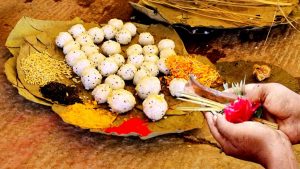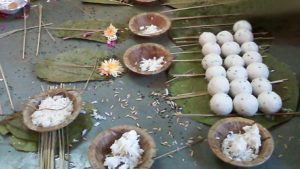Rituals Followed On Ugadi
Ugadi is a festival that is rich in rituals and traditions. The festive ceremonies begins early on the day, with the elderly member of the family raising as early as 4.30 a.m, chanting holy mantras. Several ceremonial rituals are followed throughout the day to mark the Ugadi festival celebration.

The following rituals are widely followed as part of the Ugadi Festival celebrations.
- Viewing Reflection in Ghee: Devotees perform a special ritual where they view their own reflection in a bowl of molten ghee.
- Enne (Oil) Shastra: The elderly woman of the family applies the sacred kumkum on the foreheads of younger family members and perform the ritual of arathi.
- Abhyang: It is a tradition that all members of the family must take oil bath, which is considered a holy ritual.
- New Dresses: New clothes are worn by all the members of the family as a mark of special celebrations.
- Abhyang for Gods: The vigrahas of the deities are usually bathed in oil.
- Offering flowers: The neem flower, mango and tamarind are offered to the Gods, signifying that the year be a mixture of bitter, sweet and sour experiences.
- Offering Puja: A number of Pujas are performed on the deities following rituals like Abhisheka, Alankara, Naivedya and Mangalarathi.
- Panchanga Pooje: On offering prayers to the God, the Panchanga or the astrological calendar for the new Samvathsara or Year is placed in front of the Lord, to be worshipped.
- Gudi or Indra Dhwaja Pooje: The sacred Indra Dhwaja Pooje is then performed to please God Indra to bless the family with prosperity.
- Front door decoration: The front entrance of the house is decorated with Kemmannu (red mud) and colourful Rangoli. Mango leaves adorns the door entrances and is considered a sign of auspiciousness. Sometimes neem leaves are also hung in place of mango leaves, since Neem leaf is also regarded as holy and possesses medicinal qualities that would fight against germs from entering the house.
- Bevu Bella: Devotees practise the custom of consuming jaggery and neem together on this auspicious day, to mark the presence of sweet and sour events in our life.
- Oota: The special feast, Oota is offered to the deity first after which everyone in the family eats the Oota or meals, as the god’s Prasada.
- Visiting temples: People traditionally visit the temples to seek the divine blessings of the almighty on this first day of the Telugu and Kannada New year.
Significance of Ugadi
Ugadi is an auspicious day which marks the change in the lunar orbit and also signifies the beginning of the new Hindu lunar calendar year. It also indicates the beginning of the spring season. Spring is that season of the year when the Mother Nature wakes up from her prolonged sleep to give rise to new plants and pastures. Spring is the most picturesque season of the earth, as the planet appears to be covered in lush greenery every where.
Just like how life blooms on this earth during the spring season, happiness and prosperity is believed to bloomed every year on this festival of new year. The word “Vasantha”in the south Indian languages of Telugu and Tamil refers to the season Spring. The festival of Vasantha Navarathri which spans for a period of nine days, commences on this new year day every year and concludes on Sri Ramnavami.
Ugadi also signifies the beginning of a new Hindu lunar calendar. It is a holy day when various sacred mantras are chanted across houses and temples. Astrological predictions for the new year is also revealed. The most important ritual of this festival is the Panchanga Shravanam, which refers to the hearing of the latest Panchanga (astrological calendar).
The sacred ritual of reading the Panchanga, also called as Panchanga Shravanam is done at the temples by the priests. Prior to reading out the annual predictions as per the Panchanga, the officiating priest mentions about the divine creator, lord Brahma, and the time taken by him for creating this universe.
The reading of the Panchanga generally involves steps. It begins with the reading of other Tidhis (wealth and prosperity) during the year and ends with the year long forecast for people from various Rashi (zodiac signs). It also gives general predictions for people from all spheres of social life. It also mentions the various benefits and strengths of a star, along with their negative impacts, based on the positioning of constellations, especially during in their transition phase.
Holy scriptures states that performing this ritual of Paanchanga Shravanam is about to bring innumerable benefits both to the listener as well as the reader. It is a sacred ritual which is considered equivalent to having a dip in the holy waters river Ganges. Upon hearing the Panchanga, one should whole heartedly thank the reader and offer him new clothes as a symbol of showing his gratitude. He must also remember to seek the blessings of the scholarly priest who did the Panchanga Shravanam.
Reach us to be a part of our whatsapp spiritual reminder group







